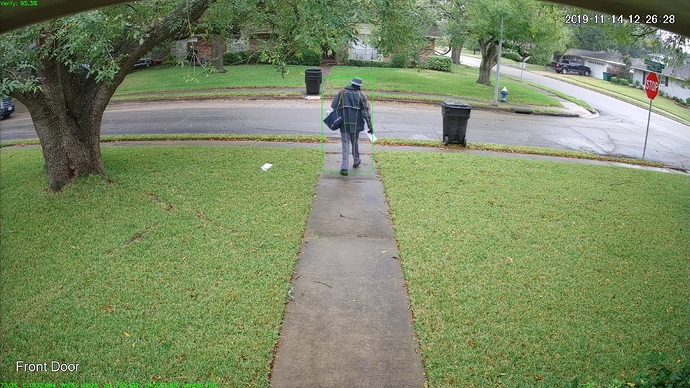There has been a huge improvements made for the Jetson Nano. Check out this: https://github.com/jkjung-avt/tensorrt_demos
Examples demonstrating how to optimize caffe/tensorflow/darknet models with TensorRT and run inferencing on NVIDIA Jetson or x86_64 PC platforms
I could not resist, had to give it a go. I was targeting to use YOLO v4 that I think is the most accurate object detector of all. So basically the demo #5 and #6 optimizing TensorRT using plugins. Well the result (for all object detectors) are pretty impressive. In addition, I was happy to see that YOLO v4 tiny now detects objects in some of my tricky images where I needed the full blown YOLO v3 to find the same.
I thought about having a kind of analyzing service in python that would utilize the new optimized engines and in addition could use mqtt to be nicely integrated with NR. Something like:
image -> mqtt -> python script analyzer service -> send result -> mqtt -> NR -> image viewer etc etc
So I made a setup flow like below. The script is running on the display just to make it easier to see the progress while detecting. I put the script in the folder /home/wk/trt_projects/tensorrt_demos. You need to change this to your specific paths, also in the exec node command line. The script assumes that the yolov4-tiny-opt-416 engine has been built. The python script itself requires a number of modules to be installed with pip3 if you do not have them installed already. The version of cv2 that is included in the latest default Jetson image is good enough, I do not make any advanced operations using cv2
[{"id":"59daad36.de7434","type":"inject","z":"85a5333b.17ff7","name":"Stop","repeat":"","crontab":"","once":false,"onceDelay":0.1,"topic":"","payload":"true","payloadType":"bool","x":110,"y":240,"wires":[["d0c00b44.5fc5c8"]]},{"id":"d0c00b44.5fc5c8","type":"change","z":"85a5333b.17ff7","name":"","rules":[{"t":"set","p":"payload","pt":"msg","to":"Stop-YOLO-Analyzer","tot":"str"}],"action":"","property":"","from":"","to":"","reg":false,"x":310,"y":240,"wires":[["ff70b4ec.d53b88"]]},{"id":"ff70b4ec.d53b88","type":"mqtt out","z":"85a5333b.17ff7","name":"","topic":"image/stop","qos":"","retain":"","broker":"5f58f95.8104a08","x":540,"y":240,"wires":[]},{"id":"cf10f9c1.719218","type":"mqtt in","z":"85a5333b.17ff7","name":"","topic":"result","qos":"2","datatype":"auto","broker":"5f58f95.8104a08","x":110,"y":480,"wires":[["93d86af8.87ed88"]]},{"id":"20c50622.29e10a","type":"image viewer","z":"85a5333b.17ff7","name":"","width":"320","data":"payload","dataType":"msg","x":340,"y":540,"wires":[[]]},{"id":"93d86af8.87ed88","type":"jimp-image","z":"85a5333b.17ff7","name":"","data":"payload","dataType":"msg","ret":"img","parameter1":"","parameter1Type":"msg","parameter2":"","parameter2Type":"msg","parameter3":"","parameter3Type":"msg","parameter4":"","parameter4Type":"msg","parameter5":"","parameter5Type":"msg","parameter6":"","parameter6Type":"msg","parameter7":"","parameter7Type":"msg","parameter8":"","parameter8Type":"msg","parameterCount":0,"jimpFunction":"none","selectedJimpFunction":{"name":"none","fn":"none","description":"Just loads the image.","parameters":[]},"x":340,"y":480,"wires":[["20c50622.29e10a"]]},{"id":"15072d69.25bff3","type":"http request","z":"85a5333b.17ff7","name":"https://loremflickr.com/640/480/person","method":"GET","ret":"bin","paytoqs":false,"url":"https://loremflickr.com/640/480/person","tls":"","persist":true,"proxy":"","authType":"","x":450,"y":370,"wires":[["e2c4def1.99418","3fdd02a5.88d0fe"]]},{"id":"8f7dbdb4.6eced","type":"inject","z":"85a5333b.17ff7","name":"","props":[{"p":"payload"},{"p":"topic","vt":"str"}],"repeat":"","crontab":"","once":false,"onceDelay":0.1,"topic":"","payload":"true","payloadType":"bool","x":110,"y":370,"wires":[["15072d69.25bff3"]]},{"id":"e2c4def1.99418","type":"mqtt out","z":"85a5333b.17ff7","name":"","topic":"image/51","qos":"","retain":"","broker":"5f58f95.8104a08","x":790,"y":370,"wires":[]},{"id":"3fdd02a5.88d0fe","type":"image viewer","z":"85a5333b.17ff7","name":"","width":"320","data":"payload","dataType":"msg","x":780,"y":430,"wires":[[]]},{"id":"54643313.a69f4c","type":"exec","z":"85a5333b.17ff7","command":"export DISPLAY=:0 && xterm -geometry 96x24-150+150 -e \"cd /home/wk/trt_projects/tensorrt_demos && python3 /home/wk/trt_projects/tensorrt_demos/trt_yolov4_to_mqtt.py\"","addpay":false,"append":"","useSpawn":"false","timer":"","oldrc":false,"name":"","x":650,"y":170,"wires":[[],[],[]]},{"id":"f3494b31.ed5548","type":"inject","z":"85a5333b.17ff7","name":"Start","repeat":"","crontab":"","once":false,"onceDelay":"10","topic":"","payload":"true","payloadType":"bool","x":110,"y":100,"wires":[["54643313.a69f4c"]]},{"id":"be08ae32.8d02c","type":"comment","z":"85a5333b.17ff7","name":"Starting & stopping services","info":"","x":180,"y":60,"wires":[]},{"id":"8ba1ff8e.34d6","type":"comment","z":"85a5333b.17ff7","name":"Send images","info":"","x":130,"y":330,"wires":[]},{"id":"8c4c9f74.3f5bd","type":"comment","z":"85a5333b.17ff7","name":"View the result","info":"","x":140,"y":440,"wires":[]},{"id":"5f58f95.8104a08","type":"mqtt-broker","z":"","name":"","broker":"127.0.0.1","port":"1883","clientid":"","usetls":false,"compatmode":false,"keepalive":"60","cleansession":true,"birthTopic":"","birthQos":"0","birthPayload":"","closeTopic":"","closeQos":"0","closePayload":"","willTopic":"","willQos":"0","willPayload":""}]
The script is below (just change extension to .py). To send images to the script it is just to publish the buffer data to the broker topic. I have used image/XX where XX is a unique camera number in my case but you could use anything as XX.
trt_yolov4_to_mqtt.txt (4.1 KB)
If you decide to try demo #6 better first check your versions of TensorRT. My "old" installation showed I had 5.1.6 and that is too old for building the opt versions using plugins. Now with the new image downloaded I have 7.1.3
When you build the engines, at least this what I saw for the opt version, do plan if you want to run the Nano headless or not. I built with a monitor attached and then I got warning when running it without. So I rebuilt without monitor attached, using vnc. Then it worked fine without the warning. See here: https://github.com/jkjung-avt/tensorrt_demos/issues/194
If you start-off from a new downloaded image, see also here: https://github.com/jkjung-avt/tensorrt_demos/issues/193
The result is not disappointing, reaching around 20 fps!!!
Best regards, Walter





